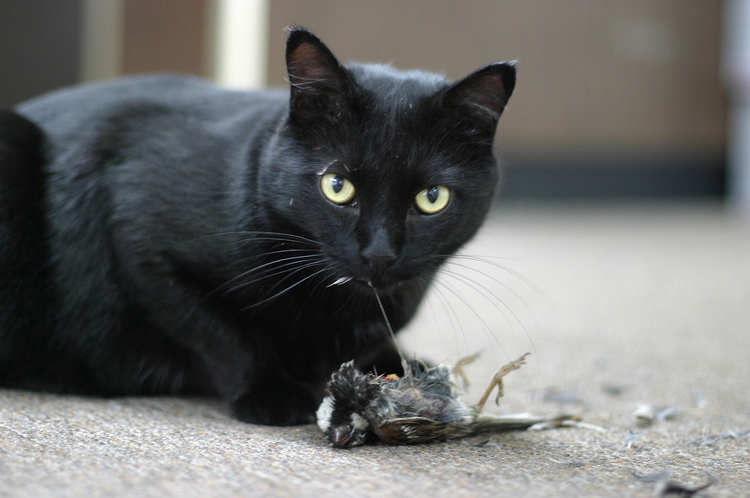Published online: May 2019
Synthesis by: Dr Yolanda van Heezik, Otago University (yolanda.vanheezik @ otago.ac.nz)
Regardless of how well-fed they are, cats kill wildlife and are also a source of disease (e.g., toxoplasma) that can kill native species and affect human health. Feral cat management is not currently contentious in New Zealand, although some felt it was wrong to exclude cats from the Predator Free New Zealand 2050 vision, even in the face of anticipated strong social opposition. However, management of stray and pet cats is certainly a problem.
In some other countries at least half of owned cats are confined 24/7, but many NZ cat owners believe that it is inhumane to prevent a cat from roaming freely. Suburban cats can roam over 16 neighbours’ properties, on average, at a density of about 225 cats per km2, meaning that urban areas are saturated with cats. New Zealand also differs in defining stray cats as distinct from feral cats, recognising a spectrum of human dependence and degree of socialisation. Stray cats fall under the purview of animal welfare charities. Trap/neuter/return (TNR) programmes are promoted as a management tool for stray cats, even though TNR is ineffective at reducing cat numbers or reducing predation of native species. Fundamentally, TNR aims to improve cat welfare, not reduce wildlife predation and disease spread.
The effectiveness of confining domestic cats is uncertain; no study has robustly demonstrated that predation by pet cats reduces populations of prey species, but designing and implementing such studies is very difficult. However, the absence of species such as common skinks from large areas of urban habitat suggests the impact of predators such as cats and hedgehogs. Night cat curfews are also not based on firm evidence as to their efficacy. Some claim that removing cats will result in meso-predator release of rats, and greater predation; however, cat presence can change rat behaviour so that they are only less likely to be seen when cats are around. Others claim that habitat loss and degradation has a much larger impact on wildlife populations than cat predation.
Some people feel that modified urban nature lacks sufficient value to be protected from predators such as cats (e.g. The National Cat Management Strategy), but a large part of the value of urban nature is the cultural ecosystem service it provides. We already know what prey species pet cats target and cats’ home range size, but little is known about stray cats. Recent research has explored attitudes to management options, perceptions of impacts, and messaging to effect behaviour change in cat owners. Citizen science programmes, such as “Cat Tracker”, are designed to provide data on spatial movements, successfully also educated cat owners and effected behavioural change.
Even if studies confirmed cat impacts on prey populations, and discounted meso-predator effects after cat confinement, this evidence would not change most cat owners’ attitudes. Effecting behaviour change requires changing social norms around cat ownership. People in Australia generally acknowledge negative impacts of pet cats and accept regulatory measures, suggesting that NZ’s population is capable of responsible cat ownership. Non-cat owners have remained a silent majority: they need to speak up and let national and local politicians know how they feel about cat management.
References
Loss, S.R., Will T., Marra P.P. 2013. The impact of free-ranging domestic cats on wildlife of the United States. Nature communications 4: 1396 https://doi.org/10.1038/ncomms2380
Loss, S.R., Marra, P.P. 2018. Merchants of doubt in the free-ranging cat conflict. Conservation Biology: The Journal of the Society for Conservation Biology. 32: 265–266. https://doi.org/10.1111/cobi.13085
Loss, S.R., Marra P.P. 2017. Population impacts of free‐ranging domestic cats on mainland vertebrates. Frontiers in Ecology and the Environment 15: 502–509
Longcore, T., Rich, C., Sullivan, L.M. 2009. Critical assessment of claims regarding management of feral cats by trap–neuter–return. Conservation Biology, 23: 887–894. https://doi.org/10.1111/j.1523-1739.2009.01174.x
Parsons, D., Michael, H., Banks, P.B., Deutsch, M.A., Munshi-South, J. 2018. Temporal and space-use changes by rats in response to predation by feral cats in an urban ecosystem. Frontiers in Ecology and Evolution 6: 146. https://doi.org/10.3389/fevo.2018.00146
Roetman, P., Tindle, H., Litchfield, C. 2018. Management of pet cats: The impact of the cat tracker citizen science project in South Australia. Animals 8: 190. https://doi.org/10.3390/ani8110190
Rouco, C., De Torre-Ceijas, R., Martín-Collado, D., Byrom. A.E. 2018. New Zealand shouldn’t ignore feral cats. BioScience 67. https://doi.org/10.1093/biosci/bix068
van Heezik, Y., Smyth, A., Adams, A., Gordon, J. 2010. Do domestic cats impose an unsustainable harvest on urban bird populations? Biological Conservation 143: 121–130. https://doi.org/10.1016/j.biocon.2009.09.013

